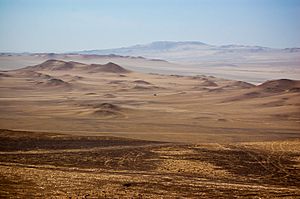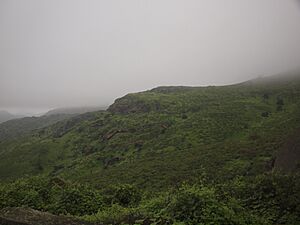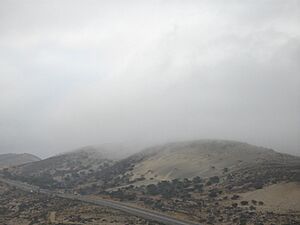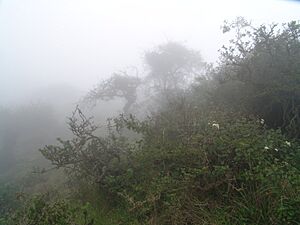Garúa facts for kids
Garúa is a Spanish word that means drizzle or mist. It's most often used to describe a cool, moist fog that happens along the coasts of Peru, southern Ecuador, and northern Chile. This usually occurs during the winter months. In Chile, garúa is known as Camanchaca.
These coastal areas in Peru, Ecuador, and Chile have a desert climate. This means they get almost no rain all year. Garúa brings mild temperatures and high humidity. It also provides much-needed moisture from the fog and mist to a region that gets very little rain. Places where this fog is common often have more vegetation. These green spots are called fog oases, or lomas.
Fog and drizzle are common near coasts and lakes. But garúa has a special and unique impact on the climate of these desert regions.
How Garúa Forms
The Humboldt Current flows along the coast of South America. This current brings very cold water from the ocean depths. It is responsible for both the desert-like climate and the garúa fog. This area covers the coasts of Peru and Chile, stretching about 2,800 kilometres (1,700 mi) from north to south.
The cold waters of the Humboldt Current create something called a temperature inversion. This means the air right near the ocean surface is cooler than the air higher up. This is the opposite of what usually happens in most places. The trade winds then blow this cool air and fog eastward over the coastal areas. As this fog moves inland, it turns into the drizzle and mist we call garúa.
Garúa is a thick fog that does not produce actual rain. The tiny water droplets in the fog are very small, only between 1 and 40 microns across. They are simply too fine to form raindrops.
Garúa's Impact on Climate
The Humboldt Current and the garúa it creates have a big effect on the local climate. For example, Lima, Peru is a city near sea level. It's located in the tropics, which usually means very warm temperatures all year, often 26 °C (79 °F) or higher. However, because of the garúa, Lima's average monthly temperatures range from 23 °C (73 °F) in the warmest months (January to March) to 17 °C (63 °F) in the coolest months (July to September). Garúa is most common during these cooler months.
The impact on sunshine is even more noticeable. Lima gets sunshine during only about 34 percent of its daylight hours each year. In July and August, the city often receives less than one hour of sunshine per day. Overall, Lima gets only 1,230 hours of sunshine annually. To compare, London, which is known for being cloudy, gets 1,573 hours of sunshine each year, and New York City gets 2,535 hours. The climate in Lima is typical of the coasts of Peru and northern Chile.
In the 1800s, American writer Herman Melville called Lima "the strangest, saddest city thou cans’t see." He said this because of the garúa clouds and mist in winter. However, today's Lima is a popular tourist spot and has been described as having a "hidden loveliness."
The desert coast, which stretches for about 1700 miles, is very dry. On average, it gets less than 10 millimetres (0.39 in) of precipitation per year. Some areas might not see rain for many years. Only the moisture that collects from the garúa clouds, along with occasional El Niño events, allows small patches of vegetation to grow. These green spots are the lomas found along the Peruvian and Chilean coasts. Except for these lomas and river valleys coming from the wetter Andes mountains, the coastal desert has almost no plants.
The garúa only reaches a few kilometers inland. It disappears over land, especially when it meets mountain slopes at heights of 300 metres (980 ft) to 1,000 metres (3,300 ft). These are the same altitudes where the vegetated lomas are found.
Collecting Water from Fog
In these dry areas, water is very hard to find. Scientists have discovered a way to collect water from the moisture-filled garúa.
In Chile, in 1985, scientists created a system to collect fog. They used special nets made of a material called polyolefin to catch the tiny water droplets in the fog. This method makes it possible to provide running water for villages in these otherwise desert regions. The Camanchacas Project set up 50 large fog-collecting nets on a mountain ridge. These nets were able to capture about 2% of the water in the fog.
In 2005, another setup using panels of 3 square metres (32 sq ft) was able to produce 5 litres (1.1 imp gal; 1.3 US gal) of water per square meter each day.
In Peru, there's an effort to protect the delicate ecosystem of the lomas, which depend on garúa for water. Conservation groups have put up fog-catching nets in the Atiquipa District. These nets collect water to help the 80 families living there expand their farming, mainly growing olives.
Related pages
- Fog
- Geography of Peru





